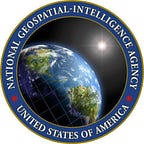By Carling Uhler, NGA Office of Corporate Communications
From the days before electricity, when sailors navigated the seas with magnetic compasses and crude charts, to the modern era of advanced scientific instruments such as GPS to guide mariners’ routes, one thing has been paramount — the need to safely navigate the Earth’s waterways.
“The American Practical Navigator,” more commonly referred to as “Bowditch” after its author, Nathanial Bowditch, has been the go-to nautical handbook since its premier publication in 1802. There’s likely a copy on the bridge of every U.S. watercraft, according to Jerry Clifford, Ph.D.
Two years ago Clifford received a phone call while on assignment at the Office of Naval Intelligence. It was from the National Geospatial-Intelligence Agency, asking if he would be interested in serving as editor of the 2017 edition of Bowditch. Clifford accepted, then embarked on a journey to “make Bowditch continue to be a great book — the epitome of marine navigation.”
Clifford refers to the book as the “‘Gray’s Anatomy’ for navigation.” Like Henry Gray’s revered tome on human anatomy, Bowditch is considered the gold standard for its field. NGA and its predecessor organizations have reviewed and updated Bowditch since the 19th century. This year marks the 150th anniversary of the U.S. government’s $25,000 purchase of the rights to the book.
Personal commitment
Clifford’s relationship with Bowditch began long before NGA asked him to update the nearly 900-page book, he said. His fondness for the book started with an admiration for the man behind it and carried through to his time as a midshipman at the U.S. Merchant Marine Academy.
“Here’s a young man, a teenager, finding errors in [Isaac] Newton’s published work, and later, dedicating his life to trying to make the sea, a very dynamic environment, as safe as possible,” Clifford said of the young Bowditch. “Him as a human being, a real person, and all that he accomplished and his legacy — it’s something that will endure for a very long time.”
As a young man standing in line at the Merchant Marine Academy bookstore, Clifford said he and his classmates were handed one book that was larger and heavier than the rest. Inside “The American Practical Navigator” the students found chapters on the fundamentals of maritime navigation, piloting or navigating along the coastline, electronic navigation, electronic charts and radar navigation, celestial navigation, mathematics, safety and regulations, oceanography and meteorology.
“You’re just a young kid when you learn marine navigation,” said Clifford. “You really are told that Bowditch is the maritime ‘bible.’ It’s such an honor [to edit the newest edition] because it’s such a rich tradition that’s dear to so many people’s hearts.”
World reach
U.S. Naval Academy midshipmen are encouraged to get Bowditch in their first days on campus, according to Clifford, who has a photo on his desk of a U.S. naval officer swearing his oath with his hand on a copy of Bowditch.
While NGA is responsible for overseeing the updates, the U.S. Coast Guard and the U.S. Navy, among others, provide updated content. Bowditch — or similar content — is mandated to be onboard every ship that flies the U.S. flag, said Clifford, and many other countries also use it. For example, the Philippine Merchant Marine Academy uses Bowditch to instruct its cadets on marine navigation and other topics.
“That’s not insignificant, as Filipinos represent one of the largest groups of professional mariners around the world,” said Clifford. “Many shipping companies hire Filipino crews for their ships.”
Clifford shared the story of a colleague who captained a German-flagged vessel, recalling that the German shipping company required Bowditch to be carried on the bridge of all ships in its fleet.
“Because 95 percent of all commerce travels around the sea, the safety of navigation is critical to the economic security of all countries,” said Clifford.
For that reason, NGA released the 2017 Bowditch at an international forum. The agency provided a copy of the new edition to every attendee of the International Hydrographic Organization conference in Monaco April 24. NGA released a digital version to the public in June.
Focused update
Clifford said he had three main focus areas when he started updating the 2017 edition of Bowditch: ensuring the accuracy of the information in the publication; reconstituting unique content deleted from previous editions, in response to received feedback from marine navigation professors across the United States; and capturing the present practice of marine navigation, including an emphasis on electronic navigation and digital charts.
Readers will see updated content and graphics throughout the 2017 edition, said Clifford. New to this edition are more than 200 links to additional information and websites, and matrix barcodes or QR codes.
The digital-only Bowditch release is new for NGA, and that’s a good thing, said Clifford.
“A digital copy makes it easier to access in our digital age and easier for students to reference on their devices, not having to lug around a heavy book to class,” he said.
Clifford also notes that navigational practices themselves have changed significantly since the first Bowditch.
That seafaring tradition, or art, of accumulating knowledge about the ocean and how to navigate it formed the basis of the first edition of Bowditch, according to Clifford.
“The Bowditch ‘bible’ is the science and the theory behind the art of navigation,” he said. “Every advance in that art has to be accounted for, explained and disseminated so that other people hear about it.”
The 2017 edition of Bowditch — “The American Practical Navigator” — is available from NGA’s maritime safety information web portal, accessed via NGA’s public website.
